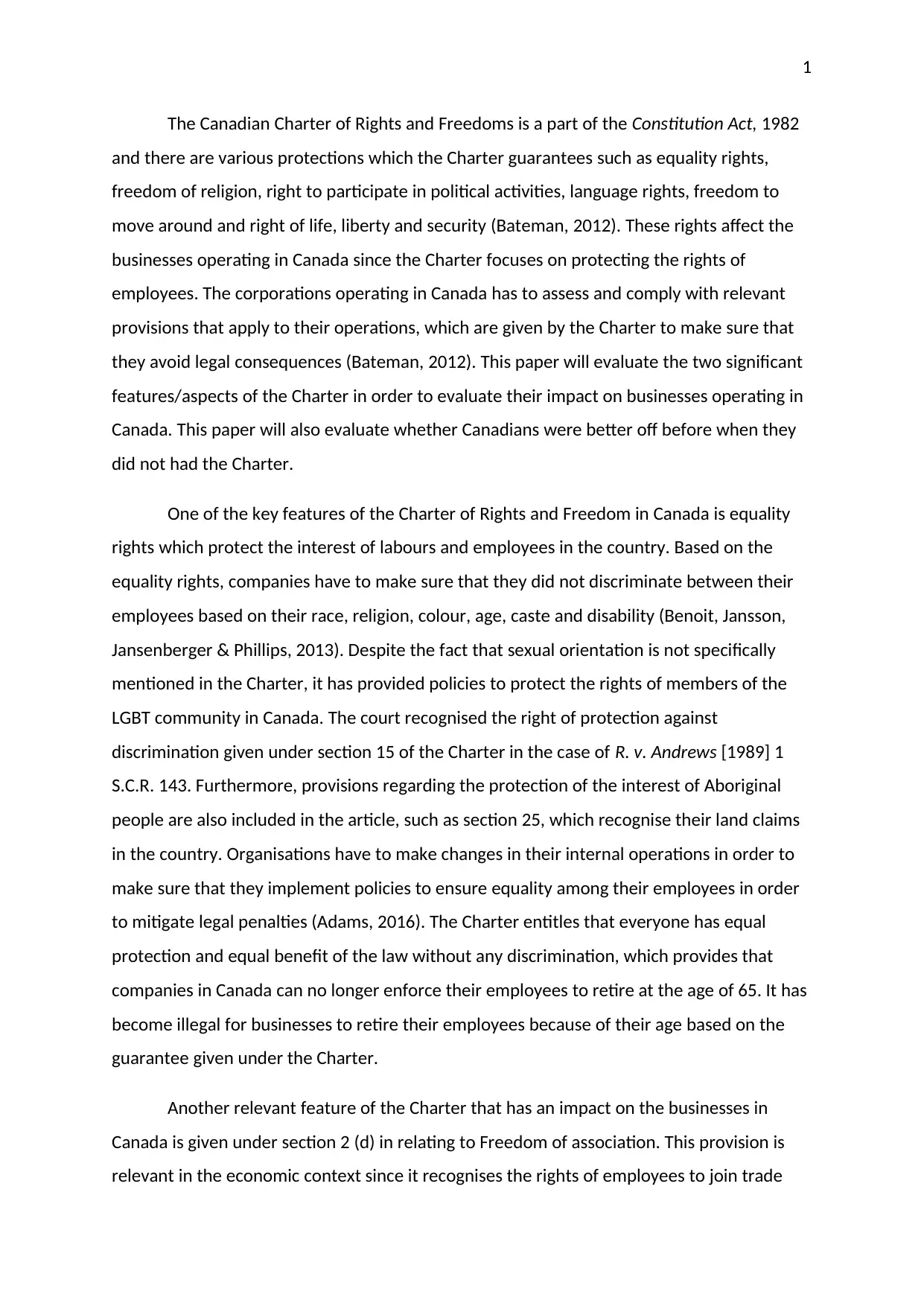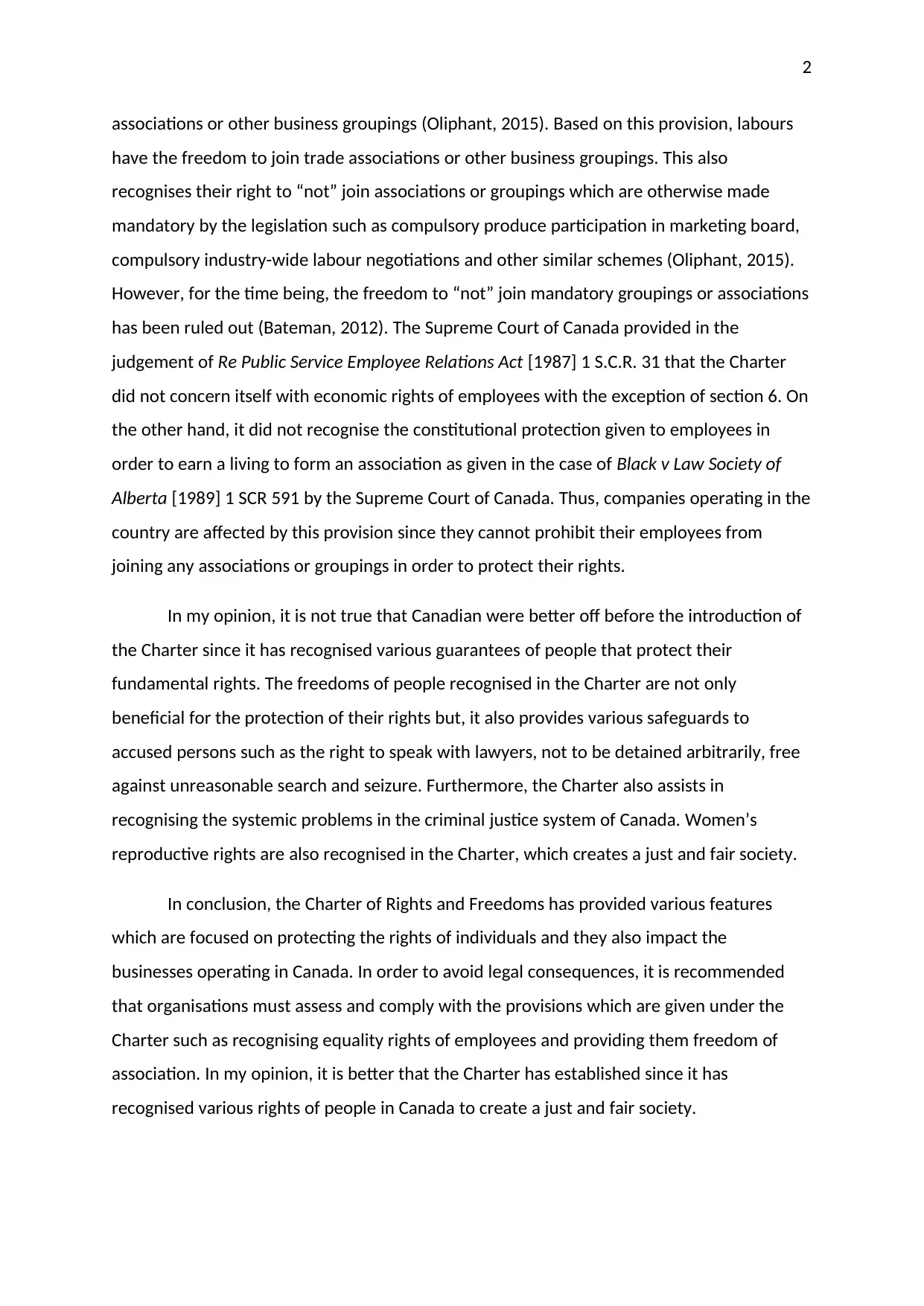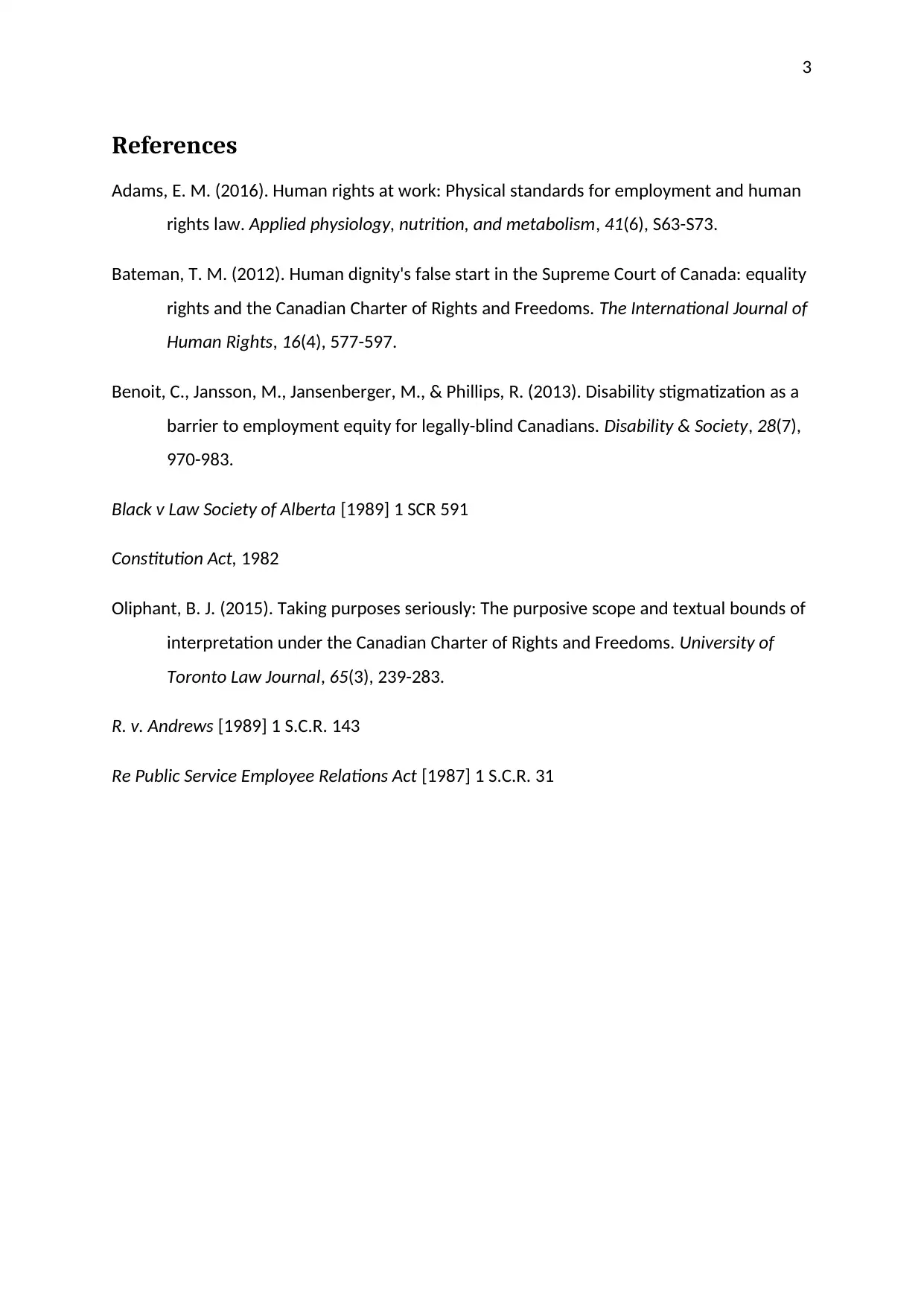Business Law 1: Impact of Canadian Charter on Businesses in Canada
VerifiedAdded on 2023/03/31
|4
|972
|113
Essay
AI Summary
This essay examines the impact of the Canadian Charter of Rights and Freedoms on businesses operating in Canada. It focuses on two key features: equality rights and freedom of association, analyzing how these provisions affect employers and employees. The essay explores the legal obligations businesses face regarding non-discrimination based on race, religion, age, and other factors, as well as the implications of freedom of association for employees' rights to join or not join trade unions and other business groupings. The author argues that the Charter has improved the protection of individual rights, including safeguards for accused persons and recognition of women's reproductive rights, concluding that the Charter has created a more just and fair society. The essay also provides a brief discussion on whether Canadians were better off before the Charter. The essay is supported by relevant case laws and academic references.

0
Business Law
Business Law
Paraphrase This Document
Need a fresh take? Get an instant paraphrase of this document with our AI Paraphraser

1
The Canadian Charter of Rights and Freedoms is a part of the Constitution Act, 1982
and there are various protections which the Charter guarantees such as equality rights,
freedom of religion, right to participate in political activities, language rights, freedom to
move around and right of life, liberty and security (Bateman, 2012). These rights affect the
businesses operating in Canada since the Charter focuses on protecting the rights of
employees. The corporations operating in Canada has to assess and comply with relevant
provisions that apply to their operations, which are given by the Charter to make sure that
they avoid legal consequences (Bateman, 2012). This paper will evaluate the two significant
features/aspects of the Charter in order to evaluate their impact on businesses operating in
Canada. This paper will also evaluate whether Canadians were better off before when they
did not had the Charter.
One of the key features of the Charter of Rights and Freedom in Canada is equality
rights which protect the interest of labours and employees in the country. Based on the
equality rights, companies have to make sure that they did not discriminate between their
employees based on their race, religion, colour, age, caste and disability (Benoit, Jansson,
Jansenberger & Phillips, 2013). Despite the fact that sexual orientation is not specifically
mentioned in the Charter, it has provided policies to protect the rights of members of the
LGBT community in Canada. The court recognised the right of protection against
discrimination given under section 15 of the Charter in the case of R. v. Andrews [1989] 1
S.C.R. 143. Furthermore, provisions regarding the protection of the interest of Aboriginal
people are also included in the article, such as section 25, which recognise their land claims
in the country. Organisations have to make changes in their internal operations in order to
make sure that they implement policies to ensure equality among their employees in order
to mitigate legal penalties (Adams, 2016). The Charter entitles that everyone has equal
protection and equal benefit of the law without any discrimination, which provides that
companies in Canada can no longer enforce their employees to retire at the age of 65. It has
become illegal for businesses to retire their employees because of their age based on the
guarantee given under the Charter.
Another relevant feature of the Charter that has an impact on the businesses in
Canada is given under section 2 (d) in relating to Freedom of association. This provision is
relevant in the economic context since it recognises the rights of employees to join trade
The Canadian Charter of Rights and Freedoms is a part of the Constitution Act, 1982
and there are various protections which the Charter guarantees such as equality rights,
freedom of religion, right to participate in political activities, language rights, freedom to
move around and right of life, liberty and security (Bateman, 2012). These rights affect the
businesses operating in Canada since the Charter focuses on protecting the rights of
employees. The corporations operating in Canada has to assess and comply with relevant
provisions that apply to their operations, which are given by the Charter to make sure that
they avoid legal consequences (Bateman, 2012). This paper will evaluate the two significant
features/aspects of the Charter in order to evaluate their impact on businesses operating in
Canada. This paper will also evaluate whether Canadians were better off before when they
did not had the Charter.
One of the key features of the Charter of Rights and Freedom in Canada is equality
rights which protect the interest of labours and employees in the country. Based on the
equality rights, companies have to make sure that they did not discriminate between their
employees based on their race, religion, colour, age, caste and disability (Benoit, Jansson,
Jansenberger & Phillips, 2013). Despite the fact that sexual orientation is not specifically
mentioned in the Charter, it has provided policies to protect the rights of members of the
LGBT community in Canada. The court recognised the right of protection against
discrimination given under section 15 of the Charter in the case of R. v. Andrews [1989] 1
S.C.R. 143. Furthermore, provisions regarding the protection of the interest of Aboriginal
people are also included in the article, such as section 25, which recognise their land claims
in the country. Organisations have to make changes in their internal operations in order to
make sure that they implement policies to ensure equality among their employees in order
to mitigate legal penalties (Adams, 2016). The Charter entitles that everyone has equal
protection and equal benefit of the law without any discrimination, which provides that
companies in Canada can no longer enforce their employees to retire at the age of 65. It has
become illegal for businesses to retire their employees because of their age based on the
guarantee given under the Charter.
Another relevant feature of the Charter that has an impact on the businesses in
Canada is given under section 2 (d) in relating to Freedom of association. This provision is
relevant in the economic context since it recognises the rights of employees to join trade

2
associations or other business groupings (Oliphant, 2015). Based on this provision, labours
have the freedom to join trade associations or other business groupings. This also
recognises their right to “not” join associations or groupings which are otherwise made
mandatory by the legislation such as compulsory produce participation in marketing board,
compulsory industry-wide labour negotiations and other similar schemes (Oliphant, 2015).
However, for the time being, the freedom to “not” join mandatory groupings or associations
has been ruled out (Bateman, 2012). The Supreme Court of Canada provided in the
judgement of Re Public Service Employee Relations Act [1987] 1 S.C.R. 31 that the Charter
did not concern itself with economic rights of employees with the exception of section 6. On
the other hand, it did not recognise the constitutional protection given to employees in
order to earn a living to form an association as given in the case of Black v Law Society of
Alberta [1989] 1 SCR 591 by the Supreme Court of Canada. Thus, companies operating in the
country are affected by this provision since they cannot prohibit their employees from
joining any associations or groupings in order to protect their rights.
In my opinion, it is not true that Canadian were better off before the introduction of
the Charter since it has recognised various guarantees of people that protect their
fundamental rights. The freedoms of people recognised in the Charter are not only
beneficial for the protection of their rights but, it also provides various safeguards to
accused persons such as the right to speak with lawyers, not to be detained arbitrarily, free
against unreasonable search and seizure. Furthermore, the Charter also assists in
recognising the systemic problems in the criminal justice system of Canada. Women’s
reproductive rights are also recognised in the Charter, which creates a just and fair society.
In conclusion, the Charter of Rights and Freedoms has provided various features
which are focused on protecting the rights of individuals and they also impact the
businesses operating in Canada. In order to avoid legal consequences, it is recommended
that organisations must assess and comply with the provisions which are given under the
Charter such as recognising equality rights of employees and providing them freedom of
association. In my opinion, it is better that the Charter has established since it has
recognised various rights of people in Canada to create a just and fair society.
associations or other business groupings (Oliphant, 2015). Based on this provision, labours
have the freedom to join trade associations or other business groupings. This also
recognises their right to “not” join associations or groupings which are otherwise made
mandatory by the legislation such as compulsory produce participation in marketing board,
compulsory industry-wide labour negotiations and other similar schemes (Oliphant, 2015).
However, for the time being, the freedom to “not” join mandatory groupings or associations
has been ruled out (Bateman, 2012). The Supreme Court of Canada provided in the
judgement of Re Public Service Employee Relations Act [1987] 1 S.C.R. 31 that the Charter
did not concern itself with economic rights of employees with the exception of section 6. On
the other hand, it did not recognise the constitutional protection given to employees in
order to earn a living to form an association as given in the case of Black v Law Society of
Alberta [1989] 1 SCR 591 by the Supreme Court of Canada. Thus, companies operating in the
country are affected by this provision since they cannot prohibit their employees from
joining any associations or groupings in order to protect their rights.
In my opinion, it is not true that Canadian were better off before the introduction of
the Charter since it has recognised various guarantees of people that protect their
fundamental rights. The freedoms of people recognised in the Charter are not only
beneficial for the protection of their rights but, it also provides various safeguards to
accused persons such as the right to speak with lawyers, not to be detained arbitrarily, free
against unreasonable search and seizure. Furthermore, the Charter also assists in
recognising the systemic problems in the criminal justice system of Canada. Women’s
reproductive rights are also recognised in the Charter, which creates a just and fair society.
In conclusion, the Charter of Rights and Freedoms has provided various features
which are focused on protecting the rights of individuals and they also impact the
businesses operating in Canada. In order to avoid legal consequences, it is recommended
that organisations must assess and comply with the provisions which are given under the
Charter such as recognising equality rights of employees and providing them freedom of
association. In my opinion, it is better that the Charter has established since it has
recognised various rights of people in Canada to create a just and fair society.
⊘ This is a preview!⊘
Do you want full access?
Subscribe today to unlock all pages.

Trusted by 1+ million students worldwide

3
References
Adams, E. M. (2016). Human rights at work: Physical standards for employment and human
rights law. Applied physiology, nutrition, and metabolism, 41(6), S63-S73.
Bateman, T. M. (2012). Human dignity's false start in the Supreme Court of Canada: equality
rights and the Canadian Charter of Rights and Freedoms. The International Journal of
Human Rights, 16(4), 577-597.
Benoit, C., Jansson, M., Jansenberger, M., & Phillips, R. (2013). Disability stigmatization as a
barrier to employment equity for legally-blind Canadians. Disability & Society, 28(7),
970-983.
Black v Law Society of Alberta [1989] 1 SCR 591
Constitution Act, 1982
Oliphant, B. J. (2015). Taking purposes seriously: The purposive scope and textual bounds of
interpretation under the Canadian Charter of Rights and Freedoms. University of
Toronto Law Journal, 65(3), 239-283.
R. v. Andrews [1989] 1 S.C.R. 143
Re Public Service Employee Relations Act [1987] 1 S.C.R. 31
References
Adams, E. M. (2016). Human rights at work: Physical standards for employment and human
rights law. Applied physiology, nutrition, and metabolism, 41(6), S63-S73.
Bateman, T. M. (2012). Human dignity's false start in the Supreme Court of Canada: equality
rights and the Canadian Charter of Rights and Freedoms. The International Journal of
Human Rights, 16(4), 577-597.
Benoit, C., Jansson, M., Jansenberger, M., & Phillips, R. (2013). Disability stigmatization as a
barrier to employment equity for legally-blind Canadians. Disability & Society, 28(7),
970-983.
Black v Law Society of Alberta [1989] 1 SCR 591
Constitution Act, 1982
Oliphant, B. J. (2015). Taking purposes seriously: The purposive scope and textual bounds of
interpretation under the Canadian Charter of Rights and Freedoms. University of
Toronto Law Journal, 65(3), 239-283.
R. v. Andrews [1989] 1 S.C.R. 143
Re Public Service Employee Relations Act [1987] 1 S.C.R. 31
1 out of 4
Your All-in-One AI-Powered Toolkit for Academic Success.
+13062052269
info@desklib.com
Available 24*7 on WhatsApp / Email
![[object Object]](/_next/static/media/star-bottom.7253800d.svg)
Unlock your academic potential
Copyright © 2020–2025 A2Z Services. All Rights Reserved. Developed and managed by ZUCOL.

